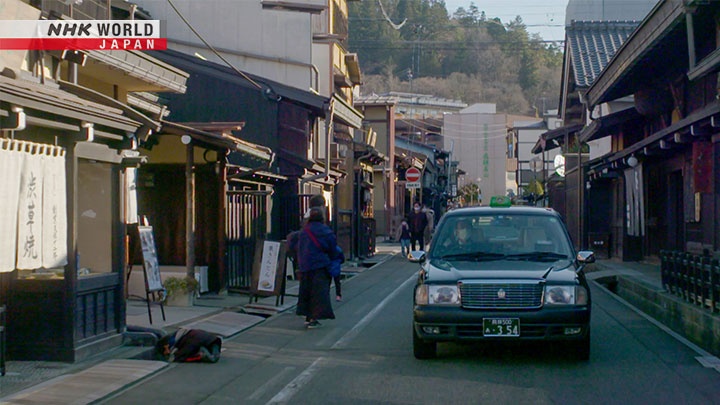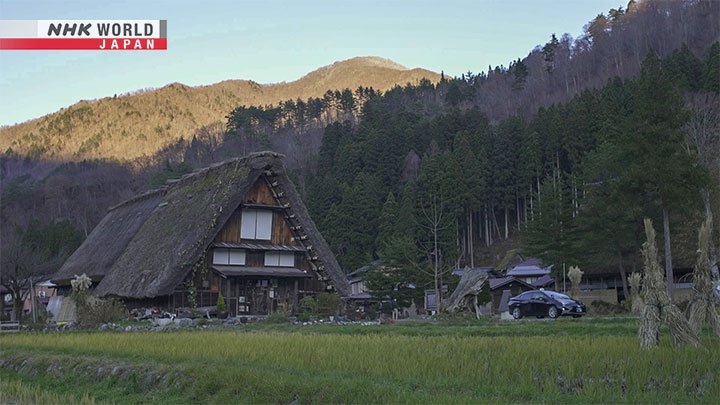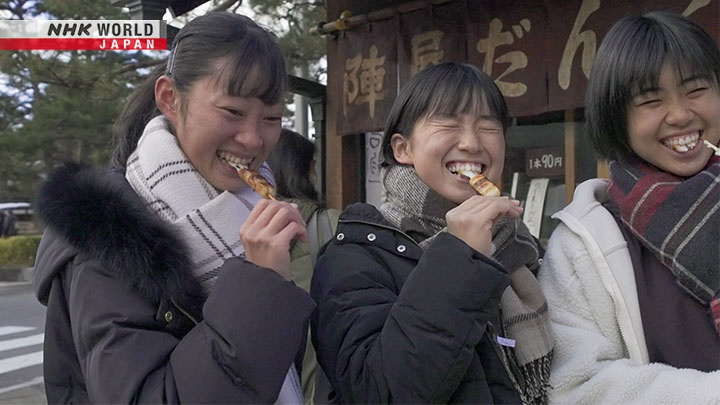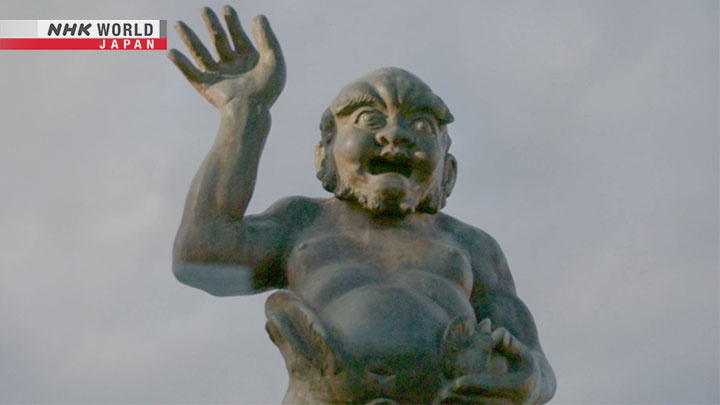A Ride Through Hida Takayama
A drive through Hida Takayama. Ride through autumn leaves, the first signs of winter in the Northern Alps, and townscapes from days past, guided by local drivers with a style and a story of their own.






Transcript
A mountain city in the northern Japanese alps, Hida Takayama, Gifu Prefecture.
- Good morning!
- Good morning!
Can I get in?
My pleasure. Please get in.
What's that on your mask?
It's a "saru bobo" doll.
A famous local symbol.
When the snow was too deep,
children made cushions into dolls
and played inside by the hearth.
Hida Takayama, now in northern Gifu Prefecture, was once the historic province of Hida.
The townscape and culture of old Japan are alive and well here today.
I said, "I want to see the festival."
My wife said, "No, join it!"
I said, "What do you mean, join it?"
Takayama is all about
the view of the Alps.
A taxi driver sees the city and the times.
It makes me laugh, "Driving Shrine."
But this shrine is definitely
a power spot for me.
Seeing the Shirakawa mountains
like this relaxes me.
It's like I've come home.
Take a once-in-a-lifetime ride through an old-style Japanese city in the mountains.
- Were you cold?
- I thought I might freeze.
I wore a down jacket.
It's just getting started.
This is nothing in Takayama.
Where would you like to go?
It's my first time here.
Maybe some famous spots?
Understood.
So, after the incorporation
you know Takayama became
as large as the capital?
Nearly the same as Tokyo in area.
But about 92% is mountains.
And the population is just 86,000 people.
1/160th that of Tokyo.
This is the old Magistrate's office.
All along here, you can see inside.
"Takayama Jinya
National Historic Site
17th-19th century magistrate's office
Former residence of the lords of Hida Province"
Next, the old township.
There are lots of visitors today.
"Old Township
Important Preservation District
for Groups of Historic Buildings
Developed as a merchant quarter
from the 17th century"
All of these walls and doors...
They're all made from Hida cedar.
It's a local rule.
Are you from Hida Takayama?
No, I moved here about 24 years ago.
I loved it and stayed ever since.
- Where were you from originally?
- Okayama.
Always "yama," "mountain."
It's even in my name.
Right, Yasu-yama!
You'd say Takayama is closed in
by mountains, right?
But if you talk to the residents
you'll see they're very kind.
Takayama locals are simple and honest.
Next, the Great Limestone Cave.
The Ohashi Collection is there
but you can't see it from the car.
Just before the Beijing Olympics,
the block of gold was stolen.
It was on display.
The three thieves divided it
into three pieces.
And one was sent to China.
- They sold it?
- That's right.
There's a joke that it was used for
the Olympic gold medals.
- Were the thieves caught?
- Yes, they were.
Two-thirds of the gold was
recovered and returned.
It's still on display.
"Recovered gold
Hida Great Limestone Cave
Ohashi Collection Museum
In 2007, 100 kg of gold bullion was stolen
71.7 kg was returned after the thieves' capture"
After that all-too-human story...
we head up a mountain road.
This is a popular spot.
"Long-life Spring."
It's spring water from the mountains.
Drinking it is said to give long life.
Would you like some?
Wait a moment.
Here, have a drink.
We'll live long.
Okay, shall we go?
After the tunnel it all changes.
Hey mountains let us see you!
Show us your faces!
That snaking path on the right,
that's the ski area.
Hirayu Spa Ski Area.
"Hirayu Otaki Waterfall
64 m in height
Listed in 'Japan's Top 100 Waterfalls'"
By February, it freezes over.
Then the whole thing is lit up.
What a change from in town
this morning.
Suddenly winter.
You never expected this, did you?
Takayama is truly vast.
The power lines are all very high here.
It's so they don't catch on
the festival shrine floats.
In winter they sag with snow.
So, they check each one
and raise them if they're too low.
Our driver this time is from the neighboring city of Gero.
14 years ago, he married into a Takayama family.
Do you live in Takayama?
Yes. Here, in the old township.
Want to see it?
These old streets are really narrow.
- It's a historic district?
- Yes, in part.
These were common people's homes.
So, it's not really fancy as such,
but it's unchanged from the old days.
We keep our neighborhood's
shrine float in this warehouse.
Here on the right.
The float's called "Daikokutai."
We carry it from here for festivals.
"Takayama Festival
UNESCO Intangible Cultural Heritage"
We only see or touch it once a year.
It's something we look forward to.
Just the word, "festival," is exciting.
The Takayama festival looked so fun,
I married a local woman so I could see it.
I said, "I want to see the festival."
My wife said, "No, join it!"
I said, "What do you mean, join it?"
It's fun, but a lot of work too.
Everything up to
the first step out the gate.
It seems local women never
bring it up before marriage.
If they did, men might lose interest.
So, your wife never warned you?
That's right.
When I mentioned I wanted to see it,
she'd say, "You'll have a great view."
"It goes right by us," she said,
I thought that was lucky.
"It goes right through here," turns out
it meant that I'd be pulling it myself.
Nevertheless, it's a happy marriage.
And they get along well with the neighbors.
Twilight is my favorite time of day.
It's still a bit bright. Shall we wait?
"About 10 or 20 minutes?"
Yes, in 10 minutes it'll be pretty dark.
We waited with Murata to catch his favorite view.
It's not usually this bright this time of year.
Is that so?
Wasn't it dark by this time yesterday?
Yeah, ordinarily it's dark by now.
- "By 4:30 or so it's already dark, right?"
- Yeah, it was.
"Do you like days like today?"
Well, I guess so.
A bright day is a good thing.
I love to fish, I catch "ayu" (sweetfish)
in the stream back there, after work.
Almost everybody's got a beer,
sometimes they'll take a fish.
So I never have any to bring home.
- Are they all locals?
- Yeah, neighbors.
They bring beer and join me
by the river after work.
I'm usually there.
The streetlights here are all bare bulbs.
It had an old-timey feeling.
Floats can't fit through here, right?
They do. Getting through such tight spots
takes real skill to avoid hitting things.
We often go through here at night.
It may sound like boasting,
but that's my favorite part.
By all means, come and see the Takayama festival.
Even the light of the moon seems to extend a welcome invitation.
"Takayama Morning Markets
Held along the Miyagawa River
and in Jinya square"
I need to warm up my voice.
Like a singer. Here I go...
Our third day of travel.
Born in Fukuoka, today's driver has lived for nearly 50 years here in Takayama.
This is Kajibashi Bridge,
it has two unusual statues.
On the right and left in the center.
Two old men, the right one has long arms.
The left one has long legs.
The gods Tenazuchi and Ashinazuchi.
Every year in October, the Japanese gods
are said to gather for a meeting.
It's only once a year, so some gods
could forget the way and get lost.
The statues are here to point the way.
"Hey, it's over there!"
I always ask passengers
which one they like better.
How about you?
Tenazuchi or Ashinazuchi?
Me, Tenazuchi.
I'm the same.
Starting in mid-October, around here
we always sit under a heated blanket.
I stay there every day until May.
You have to sit there for 8 months,
and with long legs you wouldn't fit.
But once you're under the blanket,
long arms help you reach things, right?
They call people like that "namaka,"
"lazy bones" in the local dialect.
How come you speak so fluently?
Before this, I worked for a bus company.
- As a driver?
- No way!
Not a driver, a guider.
- You were a tour guide?
- That's right.
It turns out she moved here at the age of 16.
She came in pursuit of a dream...
I can't help but laugh about it now.
I wanted to be a singer.
Becoming a singer takes money,
years of training and going to school.
I figured guides get to sing and
visit all kinds of places, too.
We head to a spot with a view of Mt. Ontake, where the god of the mountain is said to dwell.
This is Senkoji Temple. We can go in.
You can see Mt. Ontake from here.
Over there in the clouds.
Maybe it's too cloudy to see.
You can just see it.
It's usually a better view.
The foothills are just visible.
Back there below the clouds
you can see the outline.
You may not see it, but it's there.
Can you see it? It's hard to spot.
Keep looking and you'll see it.
Maybe it's better from here, see?
You see that big fir tree, right?
At the bottom there's a cone-shaped
branch that's sticking out.
Just at the tip there.
- So that's the mountain?
- Yes.
Well... the mountain god showed us his foot, anyway.
The view from here keeps changing.
You see all those concrete pillars there?
That's a new highway bridge.
It goes through Abo Tunnel to
Matsumoto City.
Much easier to reach Tokyo.
It's been a dream for many years.
The tunnel changed things for Hida.
Aren't the mountains lovely?
Takayama is all about
the view of the North Alps.
Next, she shows us a great view of the Northern Japanese Alps.
You can see the snow, right?
That's Mt. Hotaka.
With it's beautiful rock faces, Mt. Hotaka is an alpinist's dream.
Let's stop here. It's my favorite spot.
That's Mt. Norikuradake on the right.
Then Mt. Yakedake, and the Hotaka chain.
- I can see Mt. Hotaka.
- Yeah, it's a good view.
Usually, you'd also see Yarigatake,
Sugorokudake and Kasadake out to the left.
But today you only see
Yakedake and Norikuradake.
When there's nothing around
it's so beautiful. I find it relaxing.
"'Beautiful Maiden of the Alps' (1950)
Song loved by locals and climbers
praising the beautiful mountain range
and the joys of mountaineering"
After it became a World Heritage Site
everyone says things are looking up.
And with the rise in inbound tourism
visitor numbers have really gone up.
Ogawa hails from Shirakawa village.
He takes us to a World Heritage Site in the northernmost tip of Hida.
It's been over ten years since
the new highway was fully opened.
Takayama to Shirakawa was 2 hours.
But now it's just 50 minutes,
less than half.
It's convenient for tourists.
But hasn't the area lost its mystique?
Maybe so, but it makes life easier.
For residents too, going shopping, etc.
All the kids go to high school in the city.
Before, it was like a boarding school.
It was too far to commute.
Now, with the highway and the busses,
they can go back and forth from home.
This tunnel here is 11 km long.
"Hida Tunnel (completed 2008)
Construction of the Tokai-Hokuriku Expressway
said to have been the most challenging to date
took roughly 9.5 years to complete"
This is where Shirakawa-go begins.
Permission is required for outside vehicles to drive through the village.
On the left is Wada House,
a national historic site.
"Wada House
National Important Cultural Property
Largest example of Gassho-style construction"
It's open to the public inside.
But half of it is an actual residence
where a couple lives.
So, there's a modern bathroom
with an electric bidet toilet.
"Is it under repair?"
They're snow guards, for winter.
They prevent damage from snow
falling off the roof.
About 50 years ago, the locals took it upon themselves to create a set of rules.
Agreeing not to sell, rent out, or tear down their historic homes built in the Gassho-style.
In 1995, the town was designated a UNESCO World Heritage Site,
and has become a popular tourist destination visited by an average of 5,000 people per day.
- What's the parking fee?
- It's ¥1,000.
"That's a little expensive."
Visitor numbers have gone up.
The fee was increased to slow the rise.
Especially in summer and autumn,
it's so crowded here.
It can take around two hours
from the expressway.
There are actual traffic jams.
And the lot is full.
Residents get stuck in traffic.
That's why they've taken steps to
control it, like raising parking fees.
They need the tourists to live but
if too many come life is impossible.
That's a real dilemma.
And they can't just say don't come.
"The fee is ¥1,000. Please pay in cash."
I've often heard it said that this is
the ideal image of old Japan.
Is this your "ideal view"?
It really is.
The village, the river, the mountain.
It never changes, but when I see it,
all my cares seem to disappear.
When I travel long distances for work,
it's always a relief to come back.
"Ahh, I'm finally home."
There used to be a similar village
below this dam.
Developments like the dam mean old houses
disappearing or being sold.
There was one in Tokyo.
Someone bought it and turned it into
a restaurant that had a folk-house look.
This was 30 or 40 years ago.
Why do we yearn for what was lost?
Perhaps, as he said, we all want a place to call home.
There's a pond here.
You can go fishing,
or go out on a pedal boat.
Oh?! They're all tied up.
Maybe they're closed for the season.
It's the wrong time of year but
lovely water plants bloom here too.
It would've been more impressive
if you had come then.
But now, not so much.
Born and raised in Hida Takayama, Horaguchi is 23.
He's been driving a taxi for two years now.
Oh, and then, back there...
There's Hashirino Shrine,
the "Driving Shrine."
It's not so impressive either,
but it is a shrine anyway.
Yes, this here on the right.
It makes me laugh, "Driving Shrine."
There's not a Shinto god here...
"This is it then?"
It's a "shrine" for vehicles.
A former auto magazine editor's car
is "enshrined" here.
He was going for a land speed record
at over 300 kph overseas.
His car flipped and spun ten times.
The car was totally destroyed,
but the driver was unharmed.
So, he's kind of worshiped like a god
among people who love cars.
I come here regularly.
I pray to avoid accidents.
This is where you pray.
Here.
A lover of all things on wheels, he decided to become a taxi driver.
In addition to cars and motorcycles, he's a big music fan too.
Whenever I have no passengers,
I usually listen to Japanese music
from the 80s.
What do you like about mountain life?
Hmm... well, I guess I'd have to say...
Maybe the fresh air?
I've been to the big city,
but the air just wasn't the same.
Takayama has lots
of sightseeing spots.
But not much entertainment.
Like department stores, or outlet malls,
no places like that.
We do have bowling and karaoke,
and there's a game center too.
But somehow when everyone
gets together to have fun,
it feels like there's nothing to do,
so it's over before it starts.
Do you have someplace that's
your "ideal view"?
Well, yes I suppose. Where?
Oh! There is one, but I'm not sure.
It's not really a beautiful place.
This is the road I took to school.
My friends lived there.
We used to play here all the time.
Coming here, really takes me back.
When I was little, they'd recently
poured concrete at that house.
The concrete was still soft.
I was curious what would happen,
so I put my handprint in it.
My parents got mad. I had to apologize.
The school is just past here.
This was my route.
The highway wasn't built yet then.
It was wide open,
with a beautiful view of the mountains.
I was sad when they put the bridge in.
It kind of spoiled the view.
As I kid, I didn't understand.
Why'd they build this big thing?
Overlapping views of childhood memories and the changing times...
There's a highway bridge being put in
right by my school now, too.
It's convenient, so naturally I use it.
These things make life easier.
But seeing them built in the place
where I grew up...
That makes me a little sad.
When I was a kid we'd swordfight
with fallen tree branches.
Or we'd stack stones we found.
When you're little,
you can play with anything.
But adults think we have to
spend money to enjoy ourselves.
Really, we can do anything.
The place where old Japan still lives.
It lives in the hearts of the local people.
While feeling the warmth of the past...
moving on toward the future.
Today, once again, a taxi through Hida Takayama.